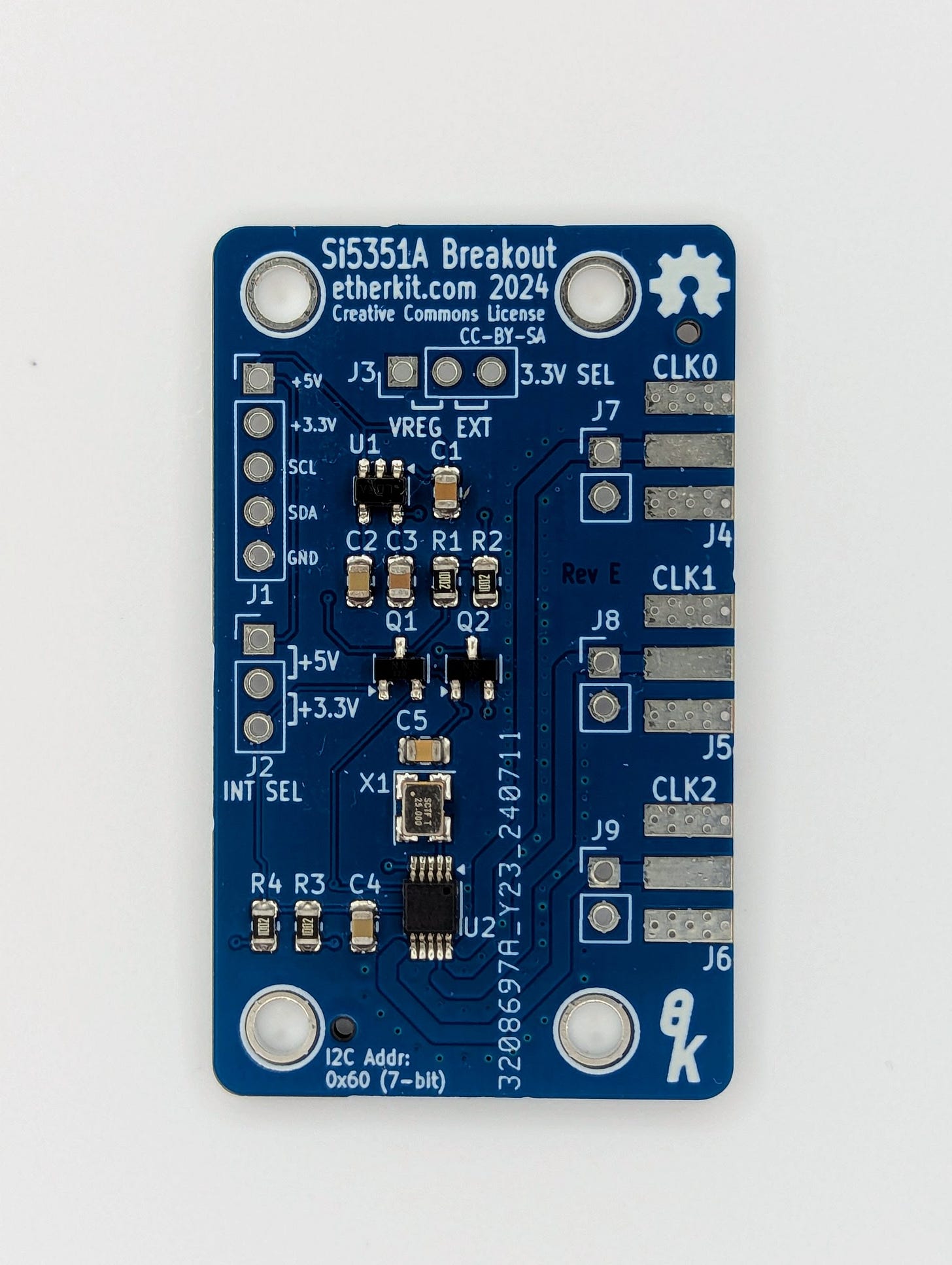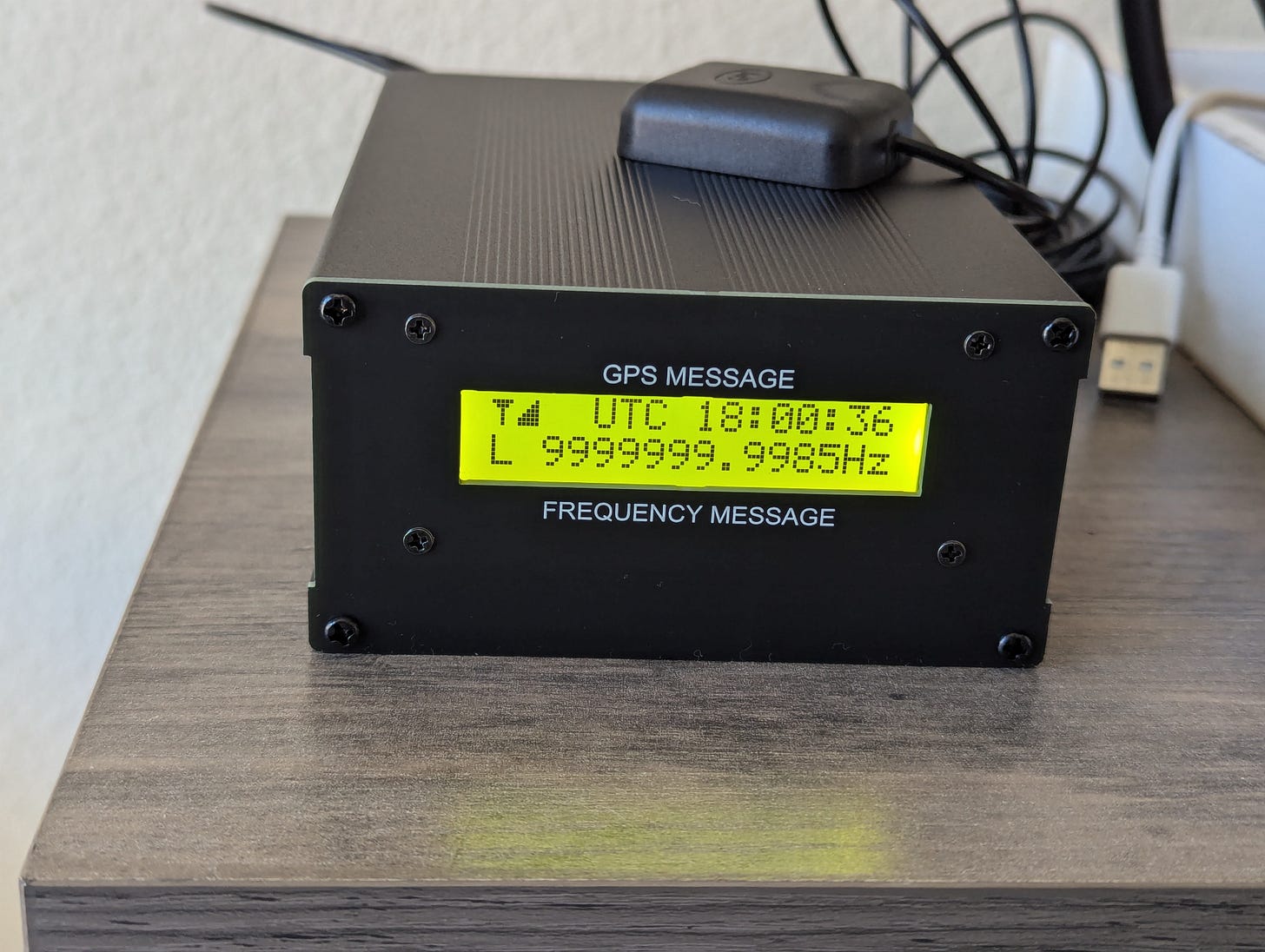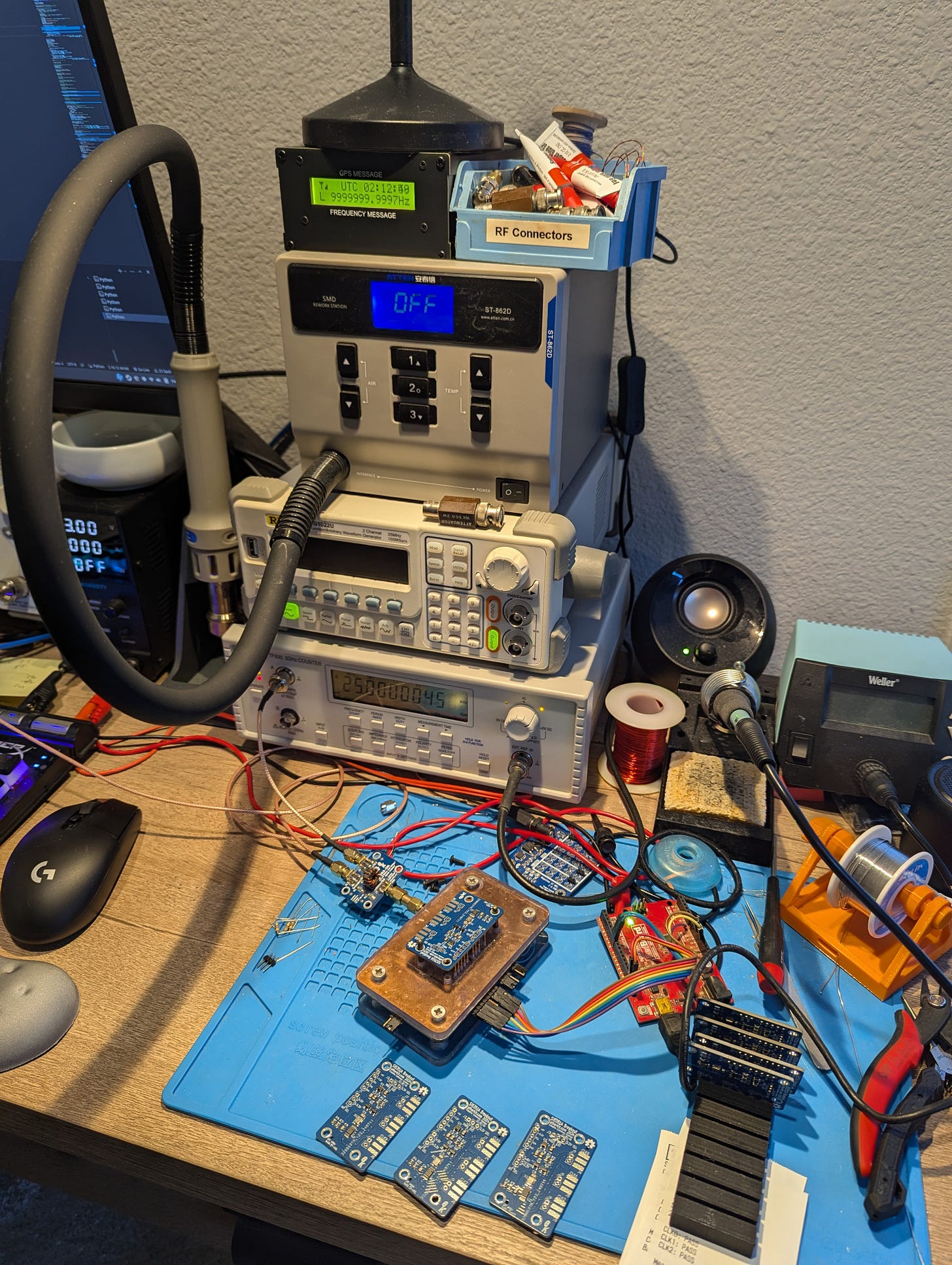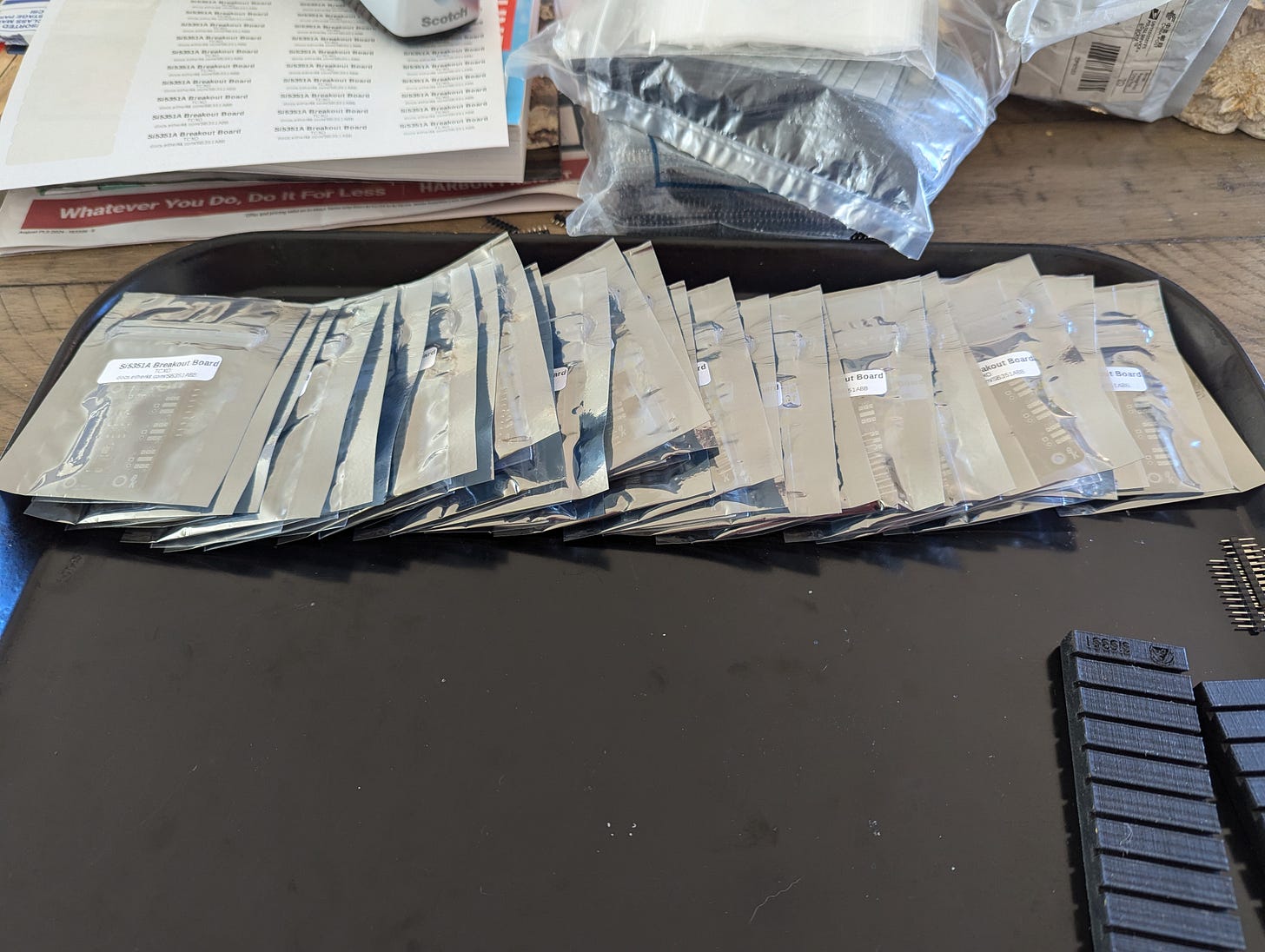I’ve had the boards back from my 2nd Project Yamhill tranche for a few weeks now, and I’ve been working my way through testing them. Included in that batch, although not directly related to Project Yamhill, was an order for both a PCB and PCB assembly for a new spin of my Si5351A Breakout Board. Since this was my first attempt at ordering PCBA, I wasn’t sure how it would go, but it was a reasonably simple board so I was optimistic.
First, allow me to give a quick overview of what changed in this new board spin. I used to sell two different SKUs of this board: one with a crystal reference and one with a TCXO reference oscillator. The TCXO version was the best seller by far, which is understandable. I maintained the crystal version so that I could at least be somewhat price competitive with others who sold similar boards for very cheap. However, I only ever sold a fraction of those cheaper boards compared to the TCXO boards, and I realized it would be impossible for me to compete on price in a race to the bottom. Therefore, I decided to focus on only supporting the TCXO version going forward, in order to make my life simpler and put scarce resources where they do the most good.
My thought process for this project was to order a moderate-sized batch of these boards and put them through my test and calibration procedure to see if they could pass. If so, then I could start selling these boards again, without having to assemble them myself. I managed to dig through the boxes packed up from my office in Beaverton and find all of the different components and accessories for the test, and was even able to squeeze all of that on my tiny desk that currently serves as my office and workbench. The GPSDO that I was previously using (a Trimble Thunderbolt generously provided by LA3PNA) wouldn’t work well here because I had to use an external antenna with a good bit of coax in order to get a good enough lock, so I decided to invest in a new BG7TBL GPSDO that could use one of those cheap puck GPS antennas.
That turned out to be a great call, as this GPSDO works quite well even with the antenna just sitting on top of the unit, inside my house. So far I’ve been really impressed with this product. It comes in a nice extruded aluminum box with silkscreened PCB end plates that look sharp. I ended up springing for the more expensive version that has a 16x2 LCD display on the front since I didn’t want to have to rely on a PC connected to the serial port to monitor the basic status of the GPS. After warming up for about 24 hours, it seems that this GPSDO can stay disciplined within about 0.5 mHz of exactly 10 MHz, which is more than good enough for my needs.
After doing some initial functional testing of a couple of the boards connected to an Arduino Uno just to make sure I got the basic functionality right, I set up my test station using the BG7TBL GPSDO, a Rigol DSA 815 for output level verification, and a TF930 frequency counter referenced to the GPSDO for the frequency calibration. Using the TF930 was a new part of my procedure, as I had acquired it in Beaverton just before I put Etherkit on hiatus but never integrated it into my test station. It gives much better frequency precision than using the frequency counter function of the DSA 815, and it has a USB UART so I can easily integrate it into my automated test system on my PC. In getting this test system back up and operational, I found some bugs in my test fixture and controlling Arduino code itself, so I had to correct those as well.
Once I got those problems worked out over a few days, I had a really solid test system working, and I was able to serialize and test all of the remaining boards on hand. Fortunately, they all worked correctly and the frequency calibrations looked to be in the range I would expect.
As you can see above, I now have a new batch of tested and calibrated Rev E Si5351A Breakout Boards ready to go on sale! At this point, I now have to do a bit more work in order to be able to actually sell them, but that moment isn’t too far in the future. I need to restart my online store, which will probably end up being procured from a service provider of some kind this time. I also need to do a pricing analysis on this new board, since the circumstances of the board’s procurement are a lot different from when I was last selling them. I’ll also need to update the documentation a bit and make sure that’s all still working correctly and has the right information. Oh, I will also need to set up my shipping station once again.
None of that should be particularly difficult, so I don’t anticipate it will be that much longer before I can do a soft re-launch of Etherkit. Exciting stuff! Watch this space for further details in the near future.
What’s Next
I did get started on that code analysis of the EtherKeyer Mini firmware that I’ve mentioned here before. I know where the bulk of the flash program space is being taken up, and I’m in the process of trying to figure out how to size optimize this code without removing functionality. I hope to get enough room freed up to add the last few core features for the keyer so that I can get it out into wider beta testing. It would be nice to have it ready in the near future for sale on the relaunched Etherkit store.
After that, I also need to build up the new spin of the Party Line 80 board to make sure it works as expected. I have a moderately good level of confidence it will be ready to go after this, but I won’t be sure until I build one. I’m also looking forward to getting this rig in the hands of beta testers.
Finally, I’ll be going back to Project Yamhill, specifically the front panel. I’ve done some testing on it and I believe that I have the digital portion working as expected now, but I may have to do some more changes to the audio section, ugh. However, details on that will have to wait a bit, since I need to do more testing and verification on what I have. You’ll definitely hear more about all this in an update in the near future. Thanks for coming along for the ride and I’m looking forward to getting back in the business of selling products again!






I really look forward to the release of your Si5351 boards with TCXO. I have installed a couple of TCXO's but would like boards with them installed! Good luck Jason!
Thanks for your hard work. Best to you!
Todd